|
|
|
Costuming Sources :: Recommended Reading & Patterns
Costume and Fashion related books for research, patterns and inspiration.

|
1870 - 1880's Bustled Apron Overskirt Pattern
by Truly Victorian
This overskirt is designed to be worn with an underskirt and bustle petticoat. It can be worn for both the early 1870's, or the 1880's style bustle. Victorian, Steampunk, Wild West, Living History. |

|
1870 Trained Skirt Ensemble Pattern
by Truly Victorian
Sizes XS-2XL pattern. These skirts are drafted based on a tailoring method actually used in the 1870's. It is designed to be worn over bustle. Skirt A has the traditional five gores and two widths in back for train length. Skirt B has the five gore front and a double width back, pleated at the side back for a "pouf."
Victorian, Steampunk, SASS, Western, Wild West, Edwardian, Living History. |

|
1870's - 1880's Petticoat with Wire Bustle Pattern
by Truly Victorian
Very easy to put together. Another great Truly Victorian Pattern. This petticoat bustle is based on an actual garment as seen in Harper's Bazaar magazine. This pattern will create a moderate sized bustle, proportioned to your hip size (one size does not fit all). It can be used as support for either 1870's or 1880's style of bustle dress. Great for Victorian, Steampunk, Living History, Wild West, SASS. |

|
1872 Side Drape Overskirt Pattern
by Truly Victorian
This skirt is drafted based on an actual garment as seen in an 1872 pattern catalog. It is designed to be worn with an underskirt and petticoat. Great for Victorian, Steampunk, Edwardian, Old West, Living History. |

|
1872 Vest Basque Bodice Pattern
by Truly Victorian
Multisized 30-50" bust. This bodice is designed from a garment as shown in the November 23, 1872 issue of Harper's Bazar Magazine. Western, Victorian, Steampunk, Living History. |

|
1873 Polonaise Pattern
by Truly Victorian
Multisized 30-50" Bust. This is a polonaise with a basque back, i.e. the back has an upper bodice section overlapping a lower section with poufs. Victorian, SASS, Western Living History, Steampunk.
I have used this pattern. Suitable for a patient beginner or intermediate sewer. |

|
1883 Tailed Victorian Bodice Pattern
by Truly Victorian
This bodice is designed after a style shown in an 1883 Haper's Bazar magazine. This style was also popular in the later 1880's and 1890's, as well. Great for Victorian, Steampunk, Living History, Western, SASS. |

|
1884 Wash Overskirt Pattern by Truly Victorian
Great by itself for a short bustle steampunk skirt too!
Pattern is multi-sized XS-3XL. This overskirt design is seen in a Butterick Catalog in 1884. A very similar skirt was also found in an 1882 catalog, worn without a bustle. The design of this overskirt allows the swags and poufs to be let out flat, to allow for washing and ironing. This ability lends the name of "wash" dress, and is therefore usually made of cotton or other washable fabrics. But the elegant drapings are also suitable for fine dress fabrics as well. It is designed to be worn with an underskirt and bustle petticoat. Western, Victorian, Edwardian, Steampunk, Wild West Saloon, Living History. |

|
1885 Four-gore Underskirt Pattern
by Truly Victorian
Multisized XS-XXL pattern. This skirt is drafted based on a tailoring method actually used in the 1880's. It can be made flat in back, to be worn with an either with an overskirt or polonaise, or with the back bouffant and the front decorated. Victorian, Steampunk, Edwardian, Western, SASS, Living History. |

|
59 Authentic Turn-of-the-Century Fashion Patterns (Dover Fashion and Costumes)
Another good pattern book for Victorian/Steampunk garments from 1890 to 1896.. How to graph out a pattern, take your measurements, and adjust the pattern to fit: not super detailed on the pattern making/altering, but still do-able for a beginner that isn't afraid to try. 33 womens patterns, 21 misses and girls costumes, 2 boys, and 3 mens patterns. |

|
A History of Costume
By Carl Köhler, published 1930. Includes sixteen plates in colour and about 600 other illustrations and patterns.
Great costume book that every costumer should have, and here it is as a free eBook. |

|
Authentic Victorian Dressmaking Techniques
Reprint of a Butterick sewing book published in 1905. This is for altering and constructing garments: no patterns in this book. Covers primarily what we usually consider Edwardian fashion. Instructions for altering patterns, hand-sewing stitches, and creating shirt-blouses, skirts, wedding and evening gowns, coats, maternity wear, undergarments, children's clothing and other apparel. Also details lost arts like boning a bodice, creating bust enhancers, more.
|
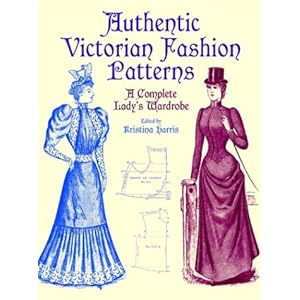
|
Authentic Victorian Fashion Patterns: A Complete Lady's Wardrobe
One of the Dover books on costume. This book contains sewing patterns published from 1886 to 1909. Fantastic for those interested in making Victorian and Steampunk dresses for experienced seamstresses; they will need to be altered to modern measurements. |

|
Bustle Fashions 1885-1887: 41 Patterns with Fashion Plates and Suggestions for Adaptation
Author: Frances Grimble, 446 pages.
This one I don't yet personally own, but I imagine it is of the same great quality of other Grimble books.
From Midwest Book Reviews:
Frances Grimble draws upon her many years of experience and impressive expertise to compile and edit two seminal contributions to the history of fashion -- a field in which she has established Lavolta Press as a leading resource -- to publish "Bustle Fashions 1885-1887: 41 Patterns with Fashion Plates and Suggestions for Adaptation" and its accompanying volume "Directoire Revival Fashions 1888-89: 57 Patterns with Fashion Plates and Suggestions for Adaptation". These are two exquisitely detailed and superbly illustrated resources for vintage costume creators. Each volume has detailed sketches and instructions for a total of 98 patterns to create a complete Victorian woman's wardrobe. Complete with a helpful glossary, bibliography, index, apportioning scales, and metric conversion table, "Bustle Fashions 1885-1887" and Directoire Revival Fashions 1888-1889" are both well-documented resources for authentic costume creation. Black and white illustrations from issues of "The Voice of Fashion" magazine and "The National Garment Cutter," an annual anthology of patterns help clarify the costume appearance and detail. Some of the material is from Butterick's "Delineator" magazine. For those who grew up reading the Laura Ingalls Wilder "Little House" books, images of Ma cutting dress patterns for Mary and Laura from the precious "Delineator" magazine will arise. "Each book is a self-contained resource for everyone who reproduces periods garments, whether for theater, movies, living history, Old West events, or dolls (quote from press release)." Of special note in both volumes is the Introduction providing cogent advice on how costume makers seeking to reproduce these period garments can best to utilize the books -- including the use of apportioning scales, taking measurements, determining seam allowances, and more. Both of these seminal editions are valuable and practical guides to detailed costume creation for the era, making them truly exceptional and highly recommended additions to personal, professional, academic, and community library History of Fashion instructional reference collections. |

|
Costume Close-Up: Clothing Construction and Pattern, 1750-1790
Patterns will need to be altered to fit the modern figure, so this book is geared toward an experienced seamstress/tailor. The descriptions of the garments are detailed and include information about the fabric, sewing techniques and alterations that the garment underwent. |

|
Costume in Detail: Women's Dress 1730-1930
Hundreds of detailed line drawings of historic costume taken from original garments. Garments were measured methodically and every seam and mark noted. Great to have as a companion book to Janet Arnolds' as they both researched some of the same garments. Ms. Arnold had the patterns, this book has more detail as to how it was put together and how it should look inside and out. |

|
Directoire Revival Fashions 1888-1889: 57 Patterns with Fashion Plates and Suggestions for Adaptation
Sequel to Bustle Fashions 1885-1887 by Frances Grimble. 563 pages. Provides special rulers called apportioning scales, so you can enlarge each pattern to your size. These rulers are in most of the other Lavolta Press books including all the other Frances Grimble books. For each pattern, several illustrations and descriptions are given for contemporary Butterick patterns. If you know how to swap pattern pieces and do fairly minor alterations, you can use the Butterick material to create several different looks from the same pattern. |

|
Dress Cutting -- Instructions and Illustrations for Sewing 26 Vintage 1930s Fashions
Originally printed in 1932, this book will take you through the pattern making process to make a customized foundation pattern as a template for various blouses, dresses, skirts, collars and sleeves. |

|
Eighteenth-Century Clothing at Williamsburg (Williamsburg Decorative Arts Series)
Inexpensive reference book from Amazon.
Antique clothing worn by men, women, and children in the eighteenth century offers a revealing glimpse into the lives of colonial Virginians. Accessories such as aprons, gloves, hats, handkerchiefs, fans, shoes, stockings, and undergarments are also illustrated. 79 pp.; 48 color photographs; 64 black-and-white photographs |

|
Evolution of Fashion: Pattern and Cut from 1066 to 1930
56 full-page drawings, which illustrate, in period settings, the changing trends in male and female dress from 1066 to 1930. For each of the costumes,there is a dressmaker's pattern, drawn to scale and supported by technical notes on making up. | |
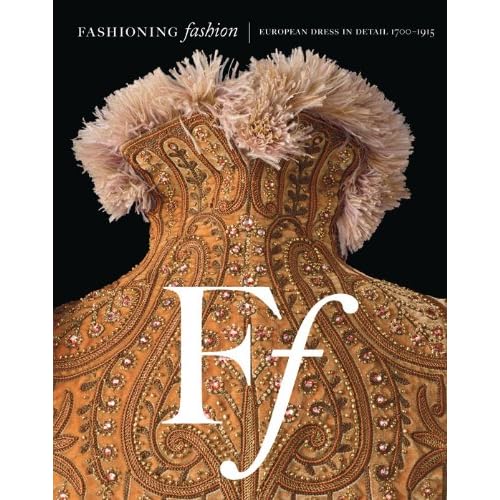
|
Fashioning Fashion: European Dress in Detail, 1700 - 1915
This book is a catalogue of the Fashioning Fashion historical clothing exhibit at LACMA. Fantastic photos. A must-have book. Another must have is "Revolution in Fashion" if you can find it. |

|
Fashions of the Gilded Age, Volume 1: Undergarments, Bodices, Skirts, Overskirts, Polonaises, and Day Dresses 1877-1882
Patterns galore! Excellent references book as well with lots of pictures. This book separates patterns for bodices, skirts, overskirts, and polonaises to mix and match however you want, or make whole dresses as-is. Multiple ways of cutting and draping a polonaise and much more. A must have for Victorian/Steampunk patterns. |

|
Fashions of the Gilded Age, Volume 2: Evening, Bridal, Sports, Outerwear, Accessories, and Dressmaking 1877-1882
Over 500 pages jam packed with patterns. Includes a dressmaking manual,chapters on accessories and trimmings contain some needlework patterns, embroidery and so on. You really should have both this book and Volume I of this series if you're serious about Victorian garment recreation. Both books good for those of an intermediate or patient beginning sewing levels. |

|
From the Neck Up
An Illustrated Guide to Hatmaking. An excellent book which I personally own. Highly recommended. |

|
How to Use, Adapt, and Design Sewing Patterns: From store-bought patterns to drafting your own
This is a general sewing book to help you modify existing patterns to fit you. Intended for fitting to a modern figure though, and not a historical silhouette, but still helpful if you are scaling up a historical pattern from a book and want to adjust it to fit you. |

|
Lady's Hoops and Bustles Pattern - 1856 - 1900
Bustles and Petticoats necessary for proper fit and drape. |
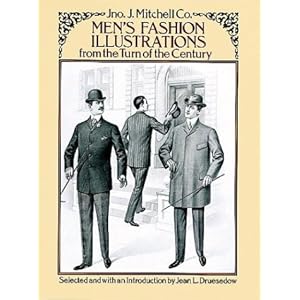
|
Men's Fashion Illustrations from the Turn of the Century (Dover Fashion and Costumes)
Over 100 full-page, royalty-free illustrations document what well-dressed American men wore in early 1900s: checked and striped business suits, sporty knickers and jackets, elegant formal wear, long fur-trimmed coats, more. Includes variety of accessories: canes, gloves, spats. Good Victorian/Steampunk reference for mens clothing. |
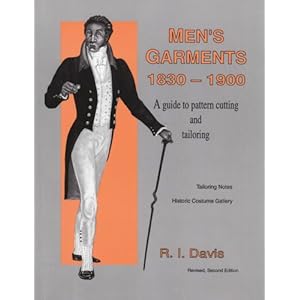
|
Men's Garments 1830-1900: A Guide to Pattern Cutting and Tailoring
Another good one for men's Victorian and Steampunk clothing. This book is for drafting patterns, and is not a tailoring guide. Patterns include: Dress Coats, Frock coats, Morning Coats, Jackets, Trousers, Pantaloons, Knickerbreeches, Waistcoats (Vests), & Topcoats. NOT for beginners. You need to understand sewing, tailoring, fitting, & pattern drafting. A determined beginner armed with books on those subjects though should be able to construct these garments or alter existing patterns/garments to these patterns. |

|
Patterns for Costume Accessories by Arnold S. Levine
Great for beginners. This book has very basic patterns and instructions for making accessory costume items. Hats & caps, spats, gaiters, slippers and soft boot patterns, cavalier cuffs, bow ties, clerical collars, jabots and cravats, an Egyptian collar, aprons, purses, baldric, sword belt, quiver and bow case pattern to name a few. |

|
Patterns for Theatrical Costumes: Garments, Trims, and Accessories from Ancient Egypt to 1915
Another book I've used extensively for basic patterns which are drawn to scale. Copy the patterns onto an overhead projector film and project it on a wall where you have hung paper and draw out your pattern. Great for medieval/renaissance fair garb. |
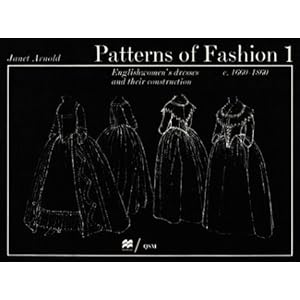
|
Patterns of Fashion 1: Englishwomen's Dresses & Their Construction C. 1660-1860
Author: Janet Arnold. Her books are a must-have for any serious historical costumer. The patterns are taken directly from actual historic garments. Meticulous sketches & descriptions of garments, coupled with her carefully drawn graphed patterns, make her books indispensable. |

|
Patterns of Fashion 2: Englishwomen's Dresses & Their Construction C. 1860-1940
Janet Arnold's clear, precise illustrations of period garments. Detailed descriptions of materials used and garment construction techniques and patterns. |

|
Patterns of Fashion 4: The Cut and Construction of Linen Shirts, Smocks, Neckwear, Headwear and Accessories for Men and Women C. 1540-1660
No one interested in the history of dress, from art historians to stage designers, from museum curators to teachers of fashion and costume, can function effectively without Janet Arnold's Patterns of Fashion series. |

|
Patterns of Fashion: The Cut and Construction of Clothes for Men and Women, C.1560-1620
Author: Janet Arnold. Clothing related to portraits and other visual sources. A careful study of individual items of clothing and tailoring techniques to assist textile conservators and archaeologists in piecing together fragments from excavations. It is also a practical guide to cutting period costumes. It should be useful to students with an interest in the history of dress and the tailor's craft. It is a wonderful source for those making models and dressing them in period costumes as a hobby. Amateur and professional costumers for theater and opera will find wonderful help in this book. The garments presented cover the periods of the reigns of Elizabeth I and James I in England. The text includes a discussion of the art and craft of the tailor. There are 56 plates of different costumes with detailed drawings and patterns for the completion of each work. This book is a wealth of material for the recreation of period costumes. |

|
Period Costume for Stage & Screen: Patterns for Women's Dress 1500-1800
These scale patterns are good for historical looking costumes for the modern figure. These are not historically accurate patterns. Foundation garment patterns included. Illustrations and descriptions of the draping process, fitting, constructing, and trimming. |

|
Revolution in Fashion: European Clothing, 1715-1815
Excellent pictorial guide to 18th and early 19th Century clothing from the Kyoto Institute of Fashion. I am fortunate to have a copy of this wonderful book. The detailed photos are amazing. If you can find this book, and afford it, you need to get it. One of my favorites. |

|
Seventeenth and Eighteenth-Century Fashion in Detail
Wonderful close up photos showing various details in historic fashions from the 17th and 18th centuries. |

|
Seventeenth-Century Women's Dress Patterns: Book 1
Published by the V&A museum. Dress patterns, construction details, embroidery, and making instructions (including a knitting pattern and lacemaking) for 15 garments and accessories from a 17th-century British woman's wardrobe. Step-by-step drawings of the construction sequence and scale patterns for each garment enable readers to accurately reconstruct them. There are scale diagrams for making linen and metal thread laces, silk braids, and embroidery designs. Multiple photographs, close-up construction details, and X-ray photography reveal the hidden elements of the clothes, the number of layers, and the stitches used inside. This first book in a new series takes the physical examination and study of historical clothing to a new depth and degree of detail, using the expertise of designers, tailors, and makers from London's Shakespeare's Globe Theatre. |

|
The Chronicle of Western Costume: From the Ancient World to the Late Twentieth Century
Here, in more than one thousand full-color illustrations, is the history of Western fashion, from ancient Egypt to twentieth-century Paris. John Peacock’s meticulous drawings are organized in chronological sections and accompanied by detailed descriptions of each figure, including the individual items of costume shown and the many types of fabric, cut, pattern, and color that have been used over the centuries. This unrivaled reference work on how people have dressed in the western world throughout history includes an illustrated glossary with additional information on technical terms. 1000+ color illustrations.
I've used this book extensively. Great go-to book for quick visual reference of various historical fashion styles. |

|
The Complete Photo Guide to Perfect Fitting
Another good book for adjusting an existing pattern to fit you using test muslin pieces then transferring the adjustments back to the pattern. Also helpful if you like to shop at thrift stores and need to make adjustments for fit. | |

|
The Costume Technician's Handbook by Rosemary Ingham
Intended for intermediate costumers, but helpful for novices. Detail concerning tools and technical sewing, materials and dyeing, drafting and creating patterns, measuring and fitting bodies, improvising props, and creating illusions. There is a section about hair and hats, and suggestions and ideas to make your own fake armour, jewelry, and shoes. It also contains a great instructions for pattern drafting, and covers costume for both men and women. This is a must have staple for your general costuming library. 544 pages. |

|
The Cut of Men's Clothes: 1600-1900 by Norah Waugh
This book traces the evolution of the style of men's dress through a sequence of diagrams accurately scaled down from patterns of actual garments, many of them rare museum specimens. The plates have been selected with the same purpose. Some are photographs of suits for which diagrams have also been given; others, reproduced from paintings and old prints, show the costume complete with its accessories. There are 27 patterns in this book. |

|
The Cut of Women's Clothes: 1600-1930 by Norah Waugh
75 cutting diagrams & 54 tailors' patterns taken from actual dresses, many of them rare museum specimens, illustrated by sketches of the dresses. There are notes on the production of women's dress, with references to early technical books and journals, together with diagrams from some of them. Numerous illustrations show the dresses as worn complete with their hairstyles, jewelry, decorations and accessories. |

|
The Edwardian Modiste: 85 Authentic Patterns with Instructions, Fashion Plates, and Period Sewing Techniques
Another great Frances Grimble book (450 pages). Original patterns from the era. Strongly recommend that you have some pattern drafting and dressmaking skills since these patterns are not to scale. There is a dressmaking manual included in the book. |

|
The Mode in Footwear: A Historical Survey with 53 Plates (Dover Fashion and Costumes)
What shoes were the height of fashion in Paris at the turn of the century? What did Tutankhamen's burial sandals look like? The answers lie in this illustrated compendium covering centuries of footwear, from Egyptian sandals, to Chinese silk wedges used for binding feet, to American saddle oxfords. Great, detailed drawings of historical footwear. |
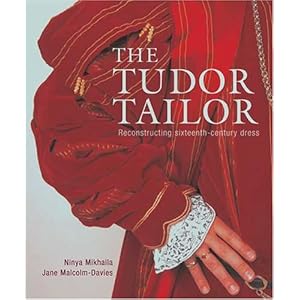
|
The Tudor Tailor: Reconstructing Sixteenth-Century Dress
A valuable sourcebook for costume designers, dressmakers and those involved in historical reenactments, this book contains all the information you need to create authentic clothes from the Tudor period. Computer-generated, historically accurate patterns enable you to make a wide range of garments, such as doublets, hose, bodices, skirts, hats and headdresses -- even underwear. There are also plenty of ideas for decoration and embellishment such as ruffs, cuffs, collars, embroidery and other surface decoration. The full range of Tudor society is represented, including lower- and middle-class clothing as well as the more sumptuous costumes from the courts of Henry VIII and Elizabeth I. There is also information on how to store and look after your finished clothing. In addition to the patterns, there are detailed drawings of each costume and information about historical context, including original paintings and source material. |

|
The Victorian Tailor: An Introduction to Period Tailoring
Invaluable to those seeking to accurately re-create period costume. Includes general chronological survey of historic drafting techniques and measuring systems and a detailed decade-by-decade timeline of men's fashion 1830-1900 to the proper tools of the tailor's trade and extremely detailed diagrams of tailoring stitches that are clear to both experts and beginners. Also covers pattern-drafting using included scales and contains patterns for waistcoats, pants, and coats, and takes you step by step through drafting, cutting and making the included examples. |

|
The Voice of Fashion: 79 Turn-of-the-Century Patterns with Instructions and Fashion Plates
Fantastic selection of womens patterns from the years 1900-1906 by author Frances Grimble. Intermediate to advanced sewing and pattern drafting skills recommended.
563 pages. |

|
Threads Sewing Guide
Another general sewing reference book, this one from Threads magazine. The book is intended for users of all sewing levels. It covers supplies, fabrics, fitting techniques and sewing pointers, from creating a seam to hand-stitching a couture garment. It also contains sections about quick fixes and stain removal. Easy to follow diagrams for tons of things like installing a zipper, add darts, change a waistline or make pleats. Includes info on sewing machines and tools. |

|
Victorian and Edwardian Fashion: A Photographic Survey
A photohistorian documents bonnets, capes, frock coats, caps, shawls, bodices, and crinolines as people actually wore them from 1840 through 1914. More than 200 photos depict aristocrats and the middle class as well as Oscar Wilde, Lillie Langtry, Winston Churchill, Queen Victoria, and others. Commentary and annotations describe and identify the costumes. |

|
Victorian and Edwardian Fashions from "La Mode Illustrée
Over 1,000 illustrations, meticulously reproduced from rare issues of renowned fashion magazine, present a striking array of women’s fashions from 1860 to 1914: elegant evening and dinner gowns, stylish daywear, wedding ensembles, bathing costumes, mourning clothes, cycling outfits and much more; plus detailed renderings of shoes, hats, parasols, and other accessories. |

|
Victorian and Edwardian Fashions from "La Mode Illustree" (Dover Fashion and Costumes)
Over 1,000 illustrations, meticulously reproduced from rare issues of renowned fashion magazine, present a striking array of women’s fashions from 1860 to 1914: elegant evening and dinner gowns, stylish daywear, wedding ensembles, bathing costumes, mourning clothes, cycling outfits and much more; plus detailed renderings of shoes, hats, parasols, and other accessories. |

|
Victorian Fashions and Costumes from Harper's Bazar, 1867-1898 (Dover Fashion and Costumes)
A must-have for Victorian and Steampunk costume research. Also available for Kindle for a mere $3.79
Day costumes, evening wear, sports clothes, shoes, hats, other accessories in over 1,000 detailed engravings. Very thorough identification of styles, materials, colors by editor. An introduction by Stella Blum covers the history of Harper's Bazar and examines the various phases fashion went through between 1867 and 1898. |

|
What People Wore: 1,800 Illustrations from Ancient Times to the Early Twentieth Century
Excellent sourcebook with helpful illustrations. |

|
Women's Hats, Headdresses and Hairstyles: With 453 Illustrations, Medieval to Modern (Dover Fashion and Costumes)
Every costumer needs to pick up some Dover books. Most are around $10, and invaluable for historical fashion enthusiasts.
More than 400 of the author's own drawings provide an authentic record of over 1,300 years of changing fashions in women's hairstyles and headwear in England. Finely detailed images — rendered from vintage sources — depict everything from wimples and crespines worn in Anglo-Saxon times to early Victorian bonnets and pillboxes of the mid-20th century. | |
|






















































